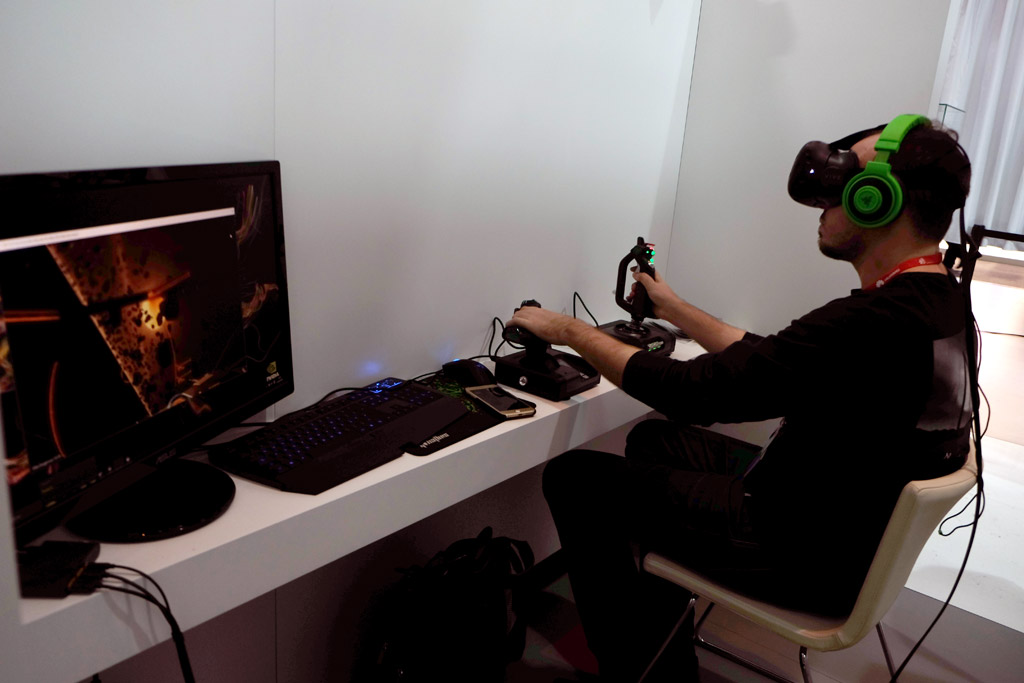
The HTC Vive is one of the most anticipated virtual reality (VR) headsets to come to market this year, and the final build was on display and available to try out on the show floor at Mobile World Congress (MWC) in Barcelona. Having tried the headset twice before, including most recently at CES in Las Vegas last month, I can say that the unit should be ready for primetime when it officially launches in April.
I won’t go into too many details about what Vive is, as that was covered in the previous hands-on post. What was different this time around was two things, in particular. First, the unit shown at MWC was a full-fledged production unit that is basically ready for consumers. Second, the demo I went through this time was a sit-down experience rather than moving around in a position-tracking situation.
Not a great deal has changed in the headset from six weeks ago. But for some minor visual tweaks to the look and feel of the device, everything is essentially the same. The same lightweight feel that characterized the device when I last wore it felt no different here. The headstrap will get a slight upgrade for comfort
One thing that wasn’t ready was Vive Phone Services, which will route incoming calls and messages from your smartphone to the headset so that you don’t have to take it off. That will be available for the consumer model, assuring no corners will be cut.
For this demo, I sat in a chair at a small desk with flight controllers to play a spaceship dogfighting game called Elite: Dangerous. The virtual cockpit not only included a large window to see a meteor shower in front of me, with a bright sun in the distance, but also the controls and lights that a futuristic fighter spaceship might have. Looking to my left, right, up or below, I was immersed in this virtual space, chasing after enemy fighters and trying to shoot them to pieces.

While I never felt disoriented with all the turns and evasive maneuvers, I will concede that this sort of thing may not be for the light-hearted. VR does play tricks with one’s mind, and those who may easily feel squeamish could end up having to stop for a breather. While it might be easier to take when the body isn’t moving, I can’t say for sure because of how subjective something like that is. Either way, the experience can be exhilarating.
I lasted about 10 minutes before time ran out on me. I could have gone longer, but there was a line of attendees waiting for their turn. Four months after I first tried the Vive in a room at a downtown Toronto hotel, the device and the content has grown immensely in sophistication and consistency. There is some hype around the Vive, and it may be deserved if things only get better from here.
It should be noted that the Vive is not the same as Samsung Gear VR, LG 360 VR or Google Cardboard. Those use a smartphone to play the content, whereas the Vive uses a powerful PC to drive what it shows, amounting to more immersive content. To be fair, it’s not an apples-to-apples comparison, and those other headsets do offer great experiences, too. Those tend to be shorter pieces, whereas the Vive is simply more capable because of the juice running it, offering longer experiences, as a result.
With the Vive confirmed to hit retail in April, and pre-orders coming up, HTC did confirm that the consumer edition will ship with two VR experiences. Job Simulator: The 2050 Archives is a basic game in an automated office where you perform menial tasks to get acclimated to how the Vive and its wireless controllers work. Fantastic Contraption has you building a machine on a grassy island floating in the sky. Beyond these two, more games and experiences will be coming, HTC says.
The full bundle will include the headset with a built-in camera and phone, two wireless VR controllers, room scale movement sensors, and the two aforementioned VR titles. Best Buy will be carrying the HTC Vive, and you can check back to see when you may be able to pre-order it ahead of its release in April.


